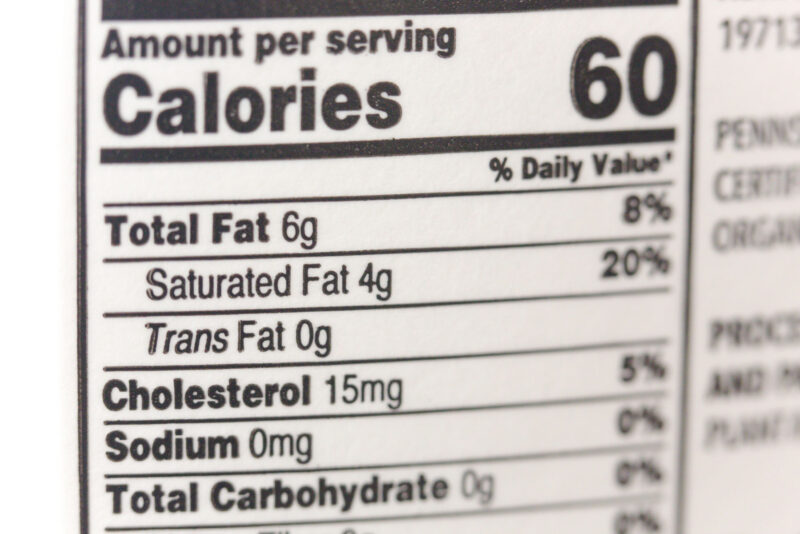Whole foods—fresh foods with a single ingredient—are among the best for metabolic health. They retain fiber and micronutrients, and they’re free of added sugars, oils, and artificial colors and flavors. But packaged foods can support nutritional needs, too, with the added bonus of convenience.
The key to intelligently incorporating packaged foods into your diet? Opt for those that are minimally processed, provide metabolism-friendly nutrients, and contain little to no added sugars. Also, steer clear of foods that appear healthy but harbor low-quality ingredients, like veggie chips loaded with flour and refined seed oil.
The trick is to disregard flashy health claims and hone in on the nutrition facts and ingredient list. Below, we break down—line by line—how to read a label so you can quickly make choices that support metabolic health.
4 Quick Steps to Reading a Food Label
Just remembering these simple steps when you look at a packaged food will decrease the likelihood you’ll be tricked into buying unhealthy food.
- Ignore the marketing language on the front. Always turn the box over and look at the food label.
- Check the serving size. This is not always the same as a typical portion size.
- Watch out for added sugar, trans fats and ingredients you don’t recognize.
- Look at DV% for micronutrients and macros, including fiber
How to Read an Ingredients List
Note the serving size
First, check the serving size, which is typically listed in cups, ounces, or pieces (with the number of grams in parentheses). Ask yourself: Does this reflect how much I normally eat of this type of food? If not, know that your portion size will contain more or less of the nutrients listed on the label.
Also understand that the serving size reflects the amount people typically eat of a particular food—it’s not a recommendation of how much to eat. You can use it as a guide, but also tune into your hunger and fullness signals when deciding how much to consume.
Pay attention to order
Ingredients are always listed in descending order by weight. Meaning, the first ingredient is present in the highest weight, followed by the second, and so on. You ideally want the first few ingredients to be recognizable, nutritious whole foods that are unlikely to spike your blood sugar. In the words of metabolic health expert Dr. Robert Lustig: “If sugar is one of the first three ingredients, it’s a dessert.”
Long lists aren’t necessarily bad
Sometimes a lengthy ingredient list equals lots of processing, other times not so much. For example, a nut mix could have over a dozen ingredients if it contains multiple herbs, spices, nuts, and seeds. What matters more are the individual foods and additives on that list.
Watch for red flags
Aim to avoid or limit foods with the following ingredients, which may spike blood sugar, compromise metabolic health, or indicate a high level of processing:
- Added sugars: cane sugar, beet sugar, date sugar, cane juice, honey, agave nectar, maple syrup, coconut sugar, brown rice syrup, oat syrup, malt syrup, molasses, carob syrup, golden syrup, high-fructose corn syrup, glucose, sucrose, fructose, maltose, fruit juice concentrate, barley malt, malt powder, etc.
- Artificial sugars: sucralose, saccharin, aspartame, dextrose, and acesulfame-K
- Grain-based flours: wheat flour, rice flour, oat flour, spelt flour, etc.
- Trans fats: partially hydrogenated vegetable oils
- Highly processed vegetable and seed oils: vegetable oil, soybean oil, corn oil, canola oil, sunflower oil, safflower oil, cottonseed oil, etc.
- Artificial colors: Red 3, Red 40, Yellow 5, Yellow 6, Blue 1, Blue 2, etc.
- Artificial flavors: Often listed as “artificial flavor”
- Double check what you don’t recognize: Ingredients you’re unfamiliar with aren’t necessarily bad for you. For example, acetic acid (another name for vinegar), mixed tocopherols (various forms of vitamin E), ascorbyl palmitate (a fat-soluble form of vitamin C), and tartaric acid (a natural component of grapes) are all safe, natural preservatives or flavor enhancers. Added vitamins may also appear sketchy at first glance—like pyridoxine hydrochloride, or vitamin B6. But sometimes those clunky words are red flags. The Environmental Working Group lists butylated hydroxyanisole (BHA), butylated hydroxytoluene (BHT), and tert-butylhydroquinone (TBHQ) among its top food additives to avoid. Don’t recognize something? Google it for a general idea of its safety.
Calories
While society has programmed us to associate “low calorie” with “health”, many high-calorie foods (like avocados, nuts, and seeds) are packed with beneficial micronutrients and phytochemicals. So even though calories is the boldest number on the nutrition label, it doesn’t provide much intel on how metabolically beneficial a food is. When considered with other factors like how much protein, fiber, and fat are in a food, it can give you a ballpark idea of how full you might feel after eating it. “It’s also helpful to consider energy density (i.e., calories) in combination with serving size,” says Rich Joseph, MD, founder of VIM Medicine. “That is helpful for calibrating a proper portion size even for healthy foods.”
Fats
When selecting packaged foods, it’s important to consider the types of fat, as some fats support metabolic health, while others may harm it.
Look for: The nutrition facts label lists total fat, saturated fat, and trans fat. While it doesn’t explicitly list unsaturated fats, you can make a rough calculation of them (total fat – saturated and trans fats = unsaturated fat). Generally, you want to avoid “partially hydrogenated oils,” choose foods that have more unsaturated fats than saturated fats, and avoid foods with low-quality oils when possible. Here are some specifics to consider:
Saturated fats
Saturated fats contain only single bonds, allowing their molecules to pack tightly so these fats remain solid at room temperature. They’re found in foods containing animal products (such as dairy, meat, and eggs) as well as tropical oils like coconut and palm.
While they may not be as harmful as once thought, you may want to cap saturated fat intake at 10% of your total daily calories (less than 22 grams if you eat 2,000 calories) if you’re generally healthy, or 5-6% (about 13 grams) if you have CVD risk factors such as high cholesterol. High saturated fat intake is associated with increased LDL cholesterol, which can increase risk of cardiovascular disease (CVD). High intake may also increase intestinal permeability (and promote systemic inflammation) or lower insulin sensitivity, which compromises blood glucose homeostasis.
Look for: Favor foods that naturally contain saturated fat and contain other high-quality ingredients (e.g. plain dairy products or grain-free crackers made with coconut oil).
Trans fats
Manufactured trans fats (a.k.a. partially hydrogenated vegetable oils) are made by adding hydrogen to liquid vegetable oils to make them solid. They are the most dangerous fat because of their negative impact on cholesterol, inflammation, and insulin response. Natural trans fats may be found in very small amounts in some meat and dairy, but research suggests they don’t pose the same health risk as man-made trans fats.
Look for: The FDA has banned their use in the U.S., but they may be found in packaged foods from other countries—so always read ingredients and avoid anything with “partially hydrogenated oils.” No specific limit has been set for natural trans fats. The WHO recommends limiting all trans fats to <1% of your total daily calories (less than 2.2 grams if you eat 2,000 calories).
Unsaturated fats
Unsaturated fats include polyunsaturated fats (omega-6 and omega-3 PUFAs) and monounsaturated fats (MUFAs). They have kinks in their molecular structure due to one or more double bonds, making them liquid at room temperature. They’re generally considered the healthiest fats—a number of human trials have found that replacing saturated fats with unsaturated fats is beneficial for reducing disease risk. But you still need to be mindful about where these fats are coming from—so always cross-reference the ingredient list.
Look for: If you see whole-food sources of unsaturated fats on the ingredient list (e.g. almonds, chia seeds, flaxseeds, pumpkin seeds, almond flour, olives), that’s a good sign. MUFA-rich oils such as avocado oil and olive oil are also widely considered healthy.
However, many packaged foods contain highly processed vegetable and seed oils (e.g. soybean oil, corn oil, canola oil, sunflower oil), which are high in omega-6 fats. These fats are relatively unstable and prone to degradation during processing. Some experts believe omega-6-rich oils may promote inflammation and elevate disease risk, though research is mixed.
Carbohydrates
Unless what you’re buying consists mostly of minimally processed, whole-food ingredients (like these seed crackers), the carbs in packaged foods tend to be processed. They may have been ground up into a flour and stripped of their fiber and nutrients altogether. This increases the likelihood that your body will rapidly break them down into glucose, leading to a sharp spike in blood sugar and insulin. The worst offenders are foods made with added sugars and refined grain flours. But even products labeled “whole grain” (like breads or pastas) are more likely to spike blood sugar compared with intact whole grains. This is why it’s always useful to look at the actual ingredients list and not just the marketing claims on the front of the package.
Look for: Total carb count is helpful—especially if you’re following a low-carb diet—but pay particular attention to fiber (good!) and added sugars (avoid!). This will give you a fuller picture of a packaged food’s level of processing and metabolic impact.
Added sugars
As much as possible, avoid anything with added sugars. These sugars added during food processing provide no nutritional value to food—and as of 2020, they have their own line on the nutrition facts panel so you can better avoid them. Sugar alcohols, on the other hand, are carbs that are structurally similar to sugar and have a sweet taste but provide fewer calories. In moderation, these sweeteners could be a more metabolically healthy way to get your sweet fix. Just use them sparingly (no more than one to two times a day) so you can reduce your overall compulsion for sweet flavors.
Look for: Added sugars include dextrose or sucrose, sugars from honey and syrups, and sugars from concentrated fruit or vegetable juices (see more examples in this list). They don’t include sugars naturally found in milk or whole plant foods like fruits and vegetables, though these could still impact blood sugar.
Sugar alcohols like xylitol and erythritol and natural low- and zero-calorie sweeteners like stevia, monk fruit, and allulose are unlikely to have a large impact on blood sugar.
Fiber
Fiber is a carbohydrate, but it mostly passes through the GI tract intact and doesn’t get broken down into glucose like other carbs—so it doesn’t spike blood sugar. In fact, getting enough fiber (Levels experts recommend 30 to 50 grams spread over the day) helps manage blood sugar and cholesterol, and supports a healthy gut microbiome.
Keep in mind, some manufacturers boost the fiber content of processed foods by adding fibers like inulin (a.k.a. chicory root extract) or psyllium husk. These may not have all the same benefits as naturally occurring fiber. Psyllium appears to help lower cholesterol, while inulin may not (though inulin does act as a prebiotic). And recent research suggests high doses of inulin (30 grams per day) may increase inflammation. Consuming a lot of added fibers could also cause bloating and GI upset, at least initially. The bottom line: These fibers may offer some benefit in moderation (at least compared to a fiber-less version of the same food), but naturally occurring fiber from whole and minimally processed foods are always preferable.
Look for: “Look at total carbohydrates, and then look at the dietary fiber,” advises Dr. Lustig. “What you’re looking for is a total carbohydrate-to-fiber ratio of less than 5:1.” (So if a food has 15 grams of total carbs, it should have at least 3 grams of fiber—unless it’s a food that naturally contains no fiber, like plain yogurt.)
Net carbs
The term “net carbs” isn’t legally required on nutrition labels, but some food manufacturers use it as a marketing tool. Net carbs refers to the number of carbohydrates that are absorbed by the body and have an impact on blood sugar. Just remember, even highly processed foods can achieve a low net carb number if they’re loaded with enough added fiber, so never choose a food solely based on net carbs.
Look for: If net carbs aren’t listed on the label, you can calculate them by subtracting grams of fiber, erythritol, and allulose, and half the grams of other sugar alcohols from the total carb content (total carbs – fiber – erythritol – allulose – .5(other sugar alcohols) = net carbs). For reference, many people following low-carb or keto diets limit their net carbs to 20 to 50 grams per day.
Protein
Getting enough protein in your diet can help boost satiety, curb cravings, and buffer post-meal elevations in blood sugar by slowing the rate at which food leaves the stomach. It also helps build metabolically active lean muscle when paired with resistance training.
The National Institutes of Health recommends 0.8 grams of protein per kilogram (2.2 pounds) of body weight per day, though individual needs vary based on age, sex and activity level. For a 150-pound person, that’s 54 grams.
Look for: Meals and snacks with about 20 to 30 grams per meal and some additional protein in your snacks. (Most people won’t experience any additional benefits from eating more than 30 grams of protein at once.)
Sodium
Sodium is an electrolyte mineral that’s essential for nerve and muscle function, and for maintaining normal fluid balance in the body. But too much salt in your diet can increase risk of hypertension, cardiovascular disease, and metabolic syndrome.
Keep in mind: It’s estimated that 75% of the sodium in the average American diet comes from salt that’s been added to processed foods like cold cuts, soups, and pizza. So if most of the foods you eat are whole and minimally processed, you may not have to worry about getting too much sodium from the occasional processed food—unless your doctor says otherwise.
The Chronic Disease Risk Reduction (CDRR) intake for sodium is 2,300 milligrams (mg) per day, which means sodium consumption below this amount is expected to lower chronic disease risk.
Look for: The level of “acceptable” sodium for a packaged food really depends on what else you’ve eaten and how close you are to this target on a given day. For example, a frozen meal made with high-quality ingredients that contains 500 to 600 mg of sodium could be perfectly acceptable in the context of an overall minimally processed diet.
Vitamins and minerals
Vitamins and minerals (i.e. micronutrients) play a key role in metabolic health. They can help metabolize macronutrients, regulate glucose, manage insulin production and release, deliver energy to cells, reduce inflammation, function as antioxidants, and more. So choosing nutrient-dense packaged foods can be a good strategy for overall metabolic health.
Not all vitamins and minerals found in a packaged food will necessarily be listed on the nutrition facts panel, though. The FDA only requires manufacturers to list vitamin D, calcium, iron, and potassium, because Americans tend to fall short in these micronutrients.
Certain manufacturers may choose to list additional micronutrients if their product contains significant amounts that are present naturally or added via fortification or enrichment. So if you see a long list of micronutrients on the nutrition facts panel, check the ingredients list. If it only contains foods (like this seed blend), the micronutrients are natural. If the ingredients list contains specific vitamins and minerals listed by their common and/or scientific name (like this breakfast cereal), they’ve been added and the product is likely highly processed.Look for: Packaged foods that contain 20% DV or higher represents a significant proportion of your daily needs. Generally, you don’t have to worry about overdoing it on micronutrients from food. But if you’re eating a lot of products that are fortified and enriched and you’re also supplementing with a multivitamin or individual micronutrient supplements, then you’re more likely to overshoot your goals. Make sure your cumulative intake of a given micronutrient from food and supplement sources doesn’t exceed the Tolerable Upper Intake Level (UL), the maximum daily intake unlikely to cause harm.
And keep in mind, research suggests that obtaining nutrients from whole or minimally processed foods—where they’re naturally packaged along with other naturally occurring nutrients—may be more beneficial for overall health.
% Daily Value
The percent Daily Value (%DV) listed on the right side of the nutrition facts panel is meant to help you quickly determine if a food is a good source of a nutrient or not.
A Daily Value (DV) represents the rough daily recommended amount of a given nutrient for the average adult eating 2,000 calories per day. The %DV tells you what proportion of that daily recommended amount is provided in one serving of food. According to the FDA:
- 5% DV or less of a nutrient per serving is considered low
- 20% DV or more of a nutrient per serving is considered high
Look for: You may want to seek out foods with a higher %DV for dietary fiber and various micronutrients, and a lower %DV for added sugars, sodium, and saturated fat.
While this can be helpful, it’s not perfect. Your specific nutrient needs vary based on your age, weight, sex, and physical activity level. Plus, if you’re following a low-carb, low-sugar diet, choosing products with less than 5% DV of those nutrients won’t necessarily be low enough for your goals. That’s why you should always look at the actual quantities of nutrients present (typically in grams, milligrams, or micrograms) and read the ingredient list.
Want to learn more about your metabolic health?
Levels, the health tech company behind this blog, helps people improve their metabolic health by showing how food and lifestyle impact your blood sugar, using continuous glucose monitoring (CGM), along with an app that offers personalized guidance and helps you build healthy habits. Click here to learn more about Levels.








